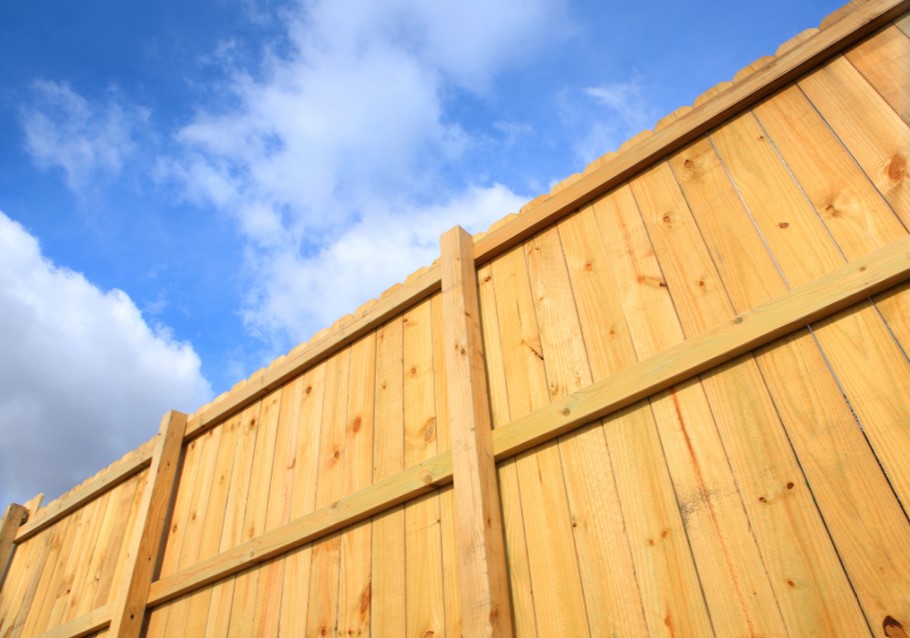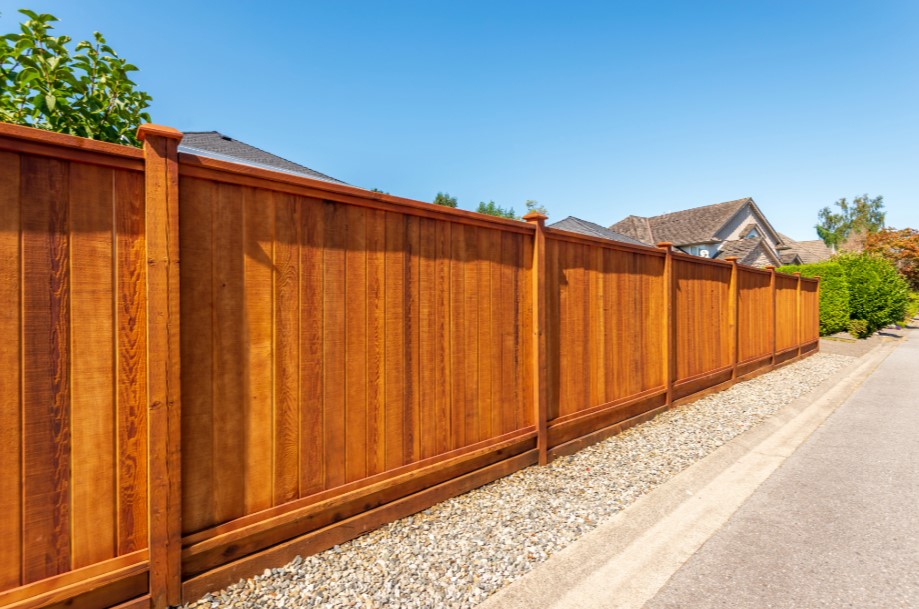
Choosing the right fencing material is important for both residential and commercial properties in New Jersey. When it comes to timeless appeal and classic charm, wood is a solid choice among various fencing materials. However, like all natural materials, wood has its unique set of challenges, one of which is warping.
Why Do Wooden Fence Panels Warp? Wooden fence panels often warp due to the inherent nature of wood to absorb and release moisture. Changes in humidity and moisture absorption cause the wood to expand and contract, leading to warping. At Eastcoast Fence, our extensive experience reveals that proper wood selection, drying, and treatment can significantly mitigate this issue, ensuring long-lasting, beautiful fences.
Warping in wooden fence panels, or warped boards, are primarily caused by moisture absorption and fluctuations in relative humidity. Wood, in its natural state, contains moisture. As it loses moisture, particularly in environments with changing humidity, it tends to twist or warp.
There are ways to prevent warping. The secret lies in choosing the right wood, drying the wood appropriately, and treating it with natural chemicals. These steps can significantly reduce moisture absorption, thereby preventing the wood from warping.
Understanding Wood’s Natural Tendencies
Since wood fence boards come from trees, they naturally contain a significant amount of water. Once the tree is cut down and processed into lumber for fence boards, it begins to lose this moisture as the board dries. The wood moving toward an equilibrium moisture content (EMC) – a state where it neither gains nor loses moisture relative to the surrounding environment.
However, the journey to EMC can be bumpy. Depending on the relative humidity and temperature, the wood may absorb moisture from or release moisture into the environment. This constant flux can cause the wood to expand and contract, leading to changes in shape, often resulting in a warped fence.
Grain Patterns and Warping
The degree of warping in fence boards depends on several factors, including the type of wood and its grain pattern. Woods with a relatively straight grain pattern tend to warp less than those with complex grain patterns.
At Eastcoast Fence, we recommend using pressure-treated wood for wooden fences. Pressure-treated wood is less susceptible to moisture absorption due to the preservatives forced into the wood under high pressure. This reduces the chances of warping, keeping your fences straight and sturdy.

Choosing the Right Wood
All wood fences have the potential to warp over time. However, by understanding wood’s natural tendencies and choosing the right materials – such as pressure-treated wood with straight grain patterns – you can significantly reduce the risk of a warped fence. Our decades of installation experience and commitment to using top-quality materials ensure that your fence remains as straight and durable as the day it was installed.
Different Types of Wood for Fencing and Their Warping Potential
Certain wood types used in fencing are more susceptible to warping due to their inherent characteristics, while others are more resistant, providing durability and longevity to your fence.
1. Cedar: Least Likely to Warp
Cedar is a popular choice for wood fencing due to its natural resistance to moisture, rot, and insects. Its straight grain pattern and low density make it less prone to warping. Its natural oils help it resist moisture absorption, reducing the chances of warping over time.
2. Redwood: Less Likely to Warp
Redwood, like cedar, contains natural oils that provide resistance against moisture and insects. Its inherent stability and minimal shrinkage properties make it a suitable choice for resisting warping.
3. Cypress: Moderately Likely to Warp
Cypress is naturally resistant to rot and decay. It’s moderately stable, but its susceptibility to warping depends on the specific growing conditions of the tree, with some cuts being more prone to warping than others.
4. Pine: More Likely to Warp
Pine is a commonly used wood for fencing due to its affordability. However, it’s more prone to warping compared to cedar or redwood. Its tendency to absorb moisture and lack of natural resistance makes it more susceptible to warping over time.
5. Spruce and Fir: Most Likely to Warp
Spruce and fir are budget-friendly options for fencing, but they are highly susceptible to warping. They lack the natural oils and density needed to resist moisture absorption, making them more prone to warping in varying weather conditions.
Understanding the natural tendencies of these wood types helps in choosing the right material for your fence. At Eastcoast Fence, we guide our customers in selecting the most suitable wood based on their preferences, budget, and the specific environmental conditions to ensure a durable and long-lasting fence that minimizes the risk of warping.
Weather and Climate Factors: Their Role in Warping Wooden Fences
At Eastcoast Fence, we’ve been providing high-quality, low-cost fencing solutions throughout New Jersey since 1999. We understand that weather and climate factors play a significant role in the longevity and durability of your wooden fences. Elements such as rain, snow, heat, and humidity can all contribute to warping, affecting the overall appearance and strength of your fence.
Rain and Snow: The Moisture Menace
When it comes to wooden fences, moisture is the main culprit behind warping. Rain and snow introduce excess moisture to your fence boards, leading them to swell and expand. While wood is designed to absorb and release moisture naturally, excessive exposure to water can supersaturate the wood, causing it to expand beyond its normal capacity.
Once the rain or snow subsides and the weather dries, these swollen boards begin to dry out and contract. However, they often don’t return to their original shape, resulting in a warped fence. This constant cycle of swelling and contracting due to rain and snow can lead to significant warping over time.
Heat and Humidity: The Expansion Experts
Just as moisture causes wood to expand, so does heat. On hot days, the increased temperature can cause your wooden fence boards to expand. Conversely, on cooler days, these boards will contract. This constant cycle of expansion and contraction can lead to warping, especially in areas with dramatic temperature fluctuations.
Humidity plays a similar role. In high humidity, wood absorbs moisture from the air, causing it to expand. In low humidity, it releases moisture, leading to contraction. Areas with high humidity levels or sudden shifts in humidity are more likely to see wooden fences warp over time.
Sudden Climate Changes: The Warp Accelerators
Sudden climate changes can exacerbate warping in wooden fences. If your area experiences a rapid shift from wet to dry conditions, or from cold to hot temperatures, your fence boards don’t have time to adjust gradually. This rapid expansion and contraction can lead to more significant warping.
Poor Installation and Maintenance: A Recipe for Warping
At Eastcoast Fence, based in Freehold, New Jersey, we’ve been providing all types of high-quality, low-cost fencing throughout New Jersey since 1999. Our extensive range of materials includes wood, vinyl, chain link, aluminum, and more.
We cater to both residential and commercial projects, ensuring that our fences stand the test of time due to our decades of installation experience and our commitment to using top-quality materials. However, even the best materials can fall victim to warping if not properly installed and maintained.

Improper Installation Techniques: The Warp Catalyst
Improper installation is a major contributor to warping in wooden fences. For instance, if fence boards are installed without allowing for the natural expansion and contraction of the wood, they can warp when subjected to changes in moisture and temperature. Similarly, if the fence is not properly aligned and leveled during installation, it can lead to uneven pressure on the boards, causing them to warp over time.
At Eastcoast Fence, we leverage our decades of installation experience to ensure that every fence is installed correctly, taking into account the natural tendencies of the wood. Our expert installers understand the importance of proper alignment and spacing, ensuring your fence remains straight and sturdy for years to come.
Maintenance: The Key to Preventing Warp
Regular maintenance is crucial to prevent warping in wooden fences. This includes sealing the wood to protect it from moisture absorption, regularly checking for signs of warp, and making necessary repairs as soon as possible.
Sealing the wood with a high-quality sealant can significantly reduce its tendency to absorb moisture, thereby reducing the risk of warping. Regular checks can help you catch signs of warp early, allowing for timely repairs. Ignoring warped boards can lead to further damage, as the warp can put additional pressure on surrounding boards, leading to a domino effect.
Avoid Warping Panels On Wooden Fences in New Jersey
Wooden fences are a beautiful, natural, and durable choice for enclosing your property. However, they do require thoughtful selection, proper installation, and regular maintenance to minimize warping over time. Conditions such as weather, climate, and sudden changes can affect the longevity and appearance of your wooden fence.
At Eastcoast Fence, we understand the nuances of these factors, leveraging our decades-long experience to ensure your fence stays as straight and sturdy as it was on installation day. With our commitment to using top-quality materials and expert installation techniques, along with our guidance on maintaining your fence, you can enjoy the beauty of a wooden fence without the worry of warping.
